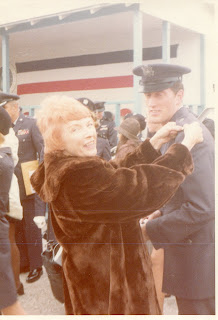About This Blog ~ This blog is about a series of Gay, Lesbian, Bisexual, and Transgender (GLBT) super-hero, sci-fi, fantasy adventure novels called Rainbow Arc of Fire. The main characters are imbued with extraordinary abilities. Their exploits are both varied and exciting, from a GLBT and a human perspective. You can follow Greg, Paul, Marina, Joan, William, and Joseph, as well as several others along the way, as they battle extraordinary foes or take on environmental threats all around the globe and even in outer space. You can access synopses of the ten books using the individual links on the upper, left-hand column.
The more recent posts are about events or issues that either are mentioned in one or more books in the series or at least influenced the writing of the series.
Monday, July 30, 2012
Two pics of those short-sleeved dress shirts, 1970's
Ann and Greg, early 1970's, Southern California
Christmas 1973 and Christmas 1974, San Pedro, CA
Sunday, July 29, 2012
Thank you!
Saturday, July 28, 2012
Mom removing my shoulder boards, December 5, 1973
Linda and I standing in front of the stands, OTS, December 5, 1973
After dismissal and the hat toss
Marching Past the review stand and then taking the oath
OTS Graduation Program, December 5, 1973
Parade Field and Reviewing Stand, OTS Graduation, December 5. 1973
Adjutant's Call 1030
Oath of Office
Brigadier General Cecil E. Fox
Commander
School of Military Sciences, Officer
George Tucker and I shaking hands afterwards
But that was all in the near and distant future. This day, like George and I getting as close to hugging one another as men got in 1973, we were all overjoyed to be in one another's company one last time.
Mom pins on my gold bars. OTS graduation, Dec 5, 1973
The classroom, OTS, Dec 5, 1973
Roommate, me, Nancy, Jim Thompson, classroom, Dec 5, 1973
Flight Commander, Brian Bauries, me, Linda and Nancy in the classroom, Dec 5, 1973
Mom and I inside the OTSOM, graduation morning, December 5, 1973
Mom and I in front of the F-102 display, OTS, December 5, 1973
Air Force OTS, 1973 (Forbes Hall F-102)
I was a small part
of a greater diminishing
in barely noticed ways.
Numbers were not the need.
And there were enough weekends
through the window where I could see
fewer officers train to salute in passing.
We are more significant now;
Not like the powerless fighter on display
winged
without insides remaining sufficient to fly.
Mom, Bill Campbell's wife, Linda Burgess, another wife, OTSOM, December 4, 1973
In front of the OTSOM, December 1973
Friday, July 27, 2012
OTS Flight picture, 1973
Several flight members at the picnic, OTS, 1973
Picnic Table pics, OTS, 1973
Two more picnic pics from OTS
More OTS Squadron Picnic Pics, 1973
Pat and his parents had lived in Cuba before and just after Castro and the revolution. They had known Castro and liked him. But after the U.S. snubbed Castro and he turned to the USSR, the Sanjenis family left and returned to the United States.
Another picnic pic, Lackland, TX 1973
Squadron Picnic, Lackland, TX, 1973
Thursday, July 26, 2012
Outside my barracks, OTS, Lackland, TX, 1973
The Officer Schools
A deep, indelible blue
on the light concrete between
marches to the sun of another day;
a cadence reminding me of a different service,
a different uniform: starched
but fading green, and rifles of Marines--
arms ordered slung to my indifference
one morning back when I trained again.
Three of us at Hondo Field, TX, 1973
Two more photos from Hondo Field, 1973
Fellow flight trainee, Hondo Field, 1973
Greg beside T-41, Hondo Field, TX, 1973
Wednesday, July 25, 2012
Flight Screening Program (FSP) fellow trainees, Hondo Field, 1973
Brian Bauries at Hondo Field, 1973
Wednesday, July 18, 2012
Me in front of OTSOM, November 1973
Friend standing in front of OTSOM in Lackland
Years later, in the 1990's, when I was visiting a guy I briefly dated who lived in Houston, though he worked in Denver, I road back to the airport and happened to look off and down from the elevated freeway. There I saw, clearly abandoned for several years, the duplex theater where we three had gone at least twenty years before.

































































